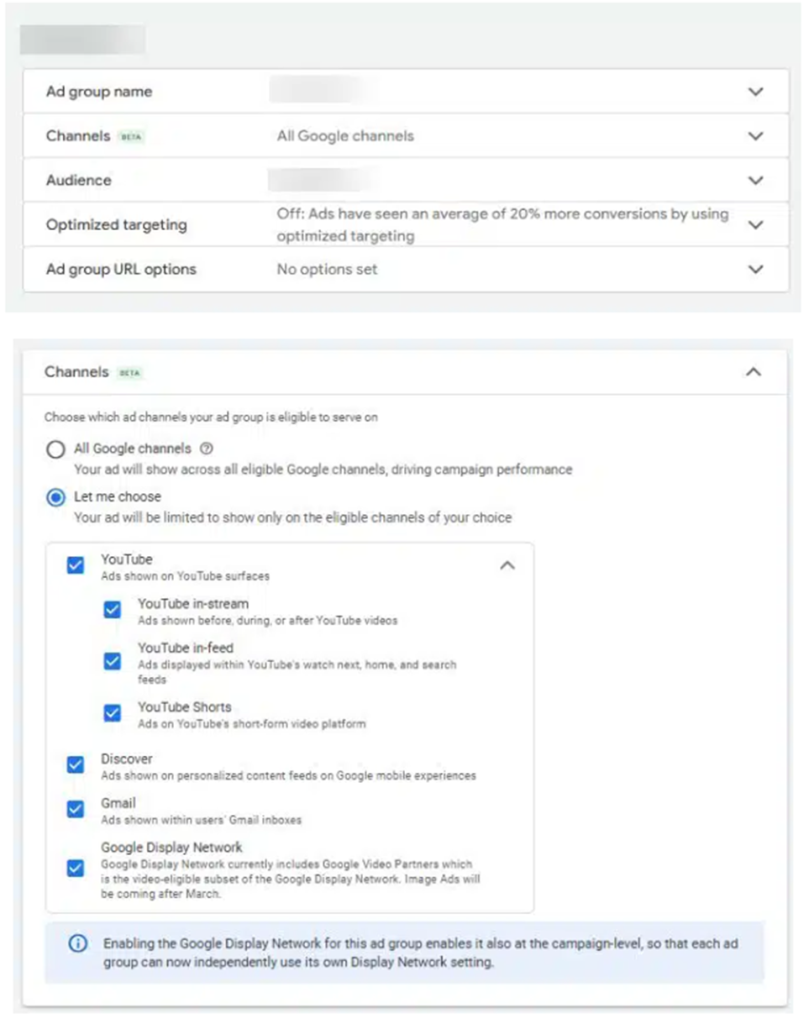
As the month of March moves into its third week, Google Ads has introduced channel control for Demand Gen campaigns, allowing advertisers to choose specific placements across platforms. This update provides more granular control over ad placement but is accompanied by reporting limitations, as performance data is currently aggregated under “Google-owned channels,” limiting data-driven adjustments. In other Google-related news, the Search Console now includes 24-hour data in its Search Performance report, which will soon be accessible via the Search Console API, enabling users to retrieve hourly data programmatically. Additionally, Google has confirmed that recent fluctuations in search results were unrelated to the upcoming March 2025 Core Update.
Google Ads Introduces Channel Control Feature for Demand Generation Campaigns
Google Ads has started implementing channel control for certain Demand Gen campaigns. This new functionality allows you to choose the specific placement of your ads on various Google platforms. While advertisers now have more detailed control over their demand generation campaigns, they continue to face challenges with reporting restrictions.
Although the feature is currently active, advertisers cannot yet segment their data by specific platform, such as YouTube, Discover, or Gmail. As a result, making informed decisions based on data will be restricted. Initially introduced in January, this update provides advertisers with greater control over ad placement, but its overall effectiveness is still uncertain due to the fact that performance metrics are grouped together under the broader category of “Google-owned channels.”
ServiceMaster’s digital marketing director, Greg Kohler, discussed a LinkedIn update he observed.
“While exciting, we won’t be making any changes until we’re able to see channel performance segmented out – as of today it’s still all lumped together as ‘Google owned channels’”.

Many search marketers are expected to delay making adjustments until Google releases a detailed analysis of channel performance metrics.
Google Search Console API to Soon Offer 24-hour Hourly Data for the Last 8 days
Google recently included 24-hour data in the Search Performance report within Google Search Console. This data will soon be accessible through the Search Console API as well, allowing users to not only view the previous 24 hours of data but also access hourly data for the past 8 days. This update enables users to programmatically retrieve the 24-hour search performance data from the Search Console API.
Daniel Waisberg, a member of Google’s Search team, made the announcement during the Google Search Central Live conference held in New York City.

Google initially stated that the “view shows information from the most recent 24 hours and will be displayed with a slight delay of just a few hours.” Additionally, Google mentioned:
“The ’24 hours’ view includes hourly granularity in an overtime graph, which is available in all 3 performance reports: Search results, Discover, and Google News. To show you data as soon as possible, Search Console will show data points as soon as we have any data on them, even if we haven’t completed collecting all the data for these points. We will indicate this in the UI using a dotted line.”
In January, Google introduced the option to download data in various file formats. Now, the company has taken it a step further by making the data accessible through an API, enabling users to integrate more up-to-date information into their in-house systems or external SEO platforms.
Having the ability to tap into this data beyond the Google Search Console web interface can be incredibly valuable for troubleshooting and uncovering new findings. With API access, you can create custom reports and dashboards that display this data in near-real-time, allowing for more in-depth analysis. However, it’s worth noting that the most recent data may not always reflect the final numbers, so it’s a good idea to revisit the data periodically, especially when generating specific reports.
Monitor this data closely, cross-check it with other export results, and analyze how you can leverage it to enhance your website and content as you move forward.
Google Clarifies Pre-March 2025 Fluctuations Unrelated to Upcoming Core Algorithm Change
Google has officially clarified that the fluctuations observed before the public release of the March 2025 Core Update were unrelated to the update itself. This confirmation was anticipated, as I had previously inquired about the connection and received a consistent response from Google on multiple occasions.
Glenn Gabe inquired Google directly and shared on X.
“Regarding the movement many sites saw starting BEFORE the core update (on 3/6), I reached out to Google about that yesterday to learn more. As I thought, Google explained that the core update was released when the core update was announced, so any movement before that *WOULD NOT* be from the March 2025 core update.”
Glenn included:
“While sharing about that volatility, I said that Google could have updated a system, or several, BEFORE the core update rolled out. Seems like that could be the case. And just a reminder that Google has always explained they could push “smaller core updates”. It was in their documentation for a while.
For example, their post about broad core updates used to contain this statement: “However, we’re constantly making updates to our search algorithms, including smaller core updates. We don’t announce all of these because they’re generally not widely noticeable. Still, when released, they can cause content to recover if improvements warrant.”
Image from the original social media post is shown below.

The fluctuations observed before the March 2025 core update were not directly tied to that particular update, as anticipated. However, it’s no secret that Google frequently implements changes without public disclosure. Regardless, we provide comprehensive coverage of both officially confirmed and unofficial updates on our platform.
Despite the volatility observed in the March 2025 core update that I previously mentioned, the current core update appears to be relatively stable. However, this could change in the future.
Online conversation taking place at X.